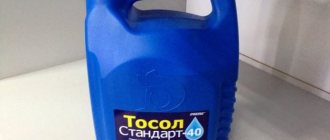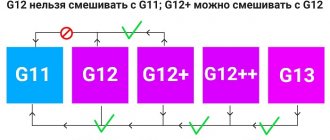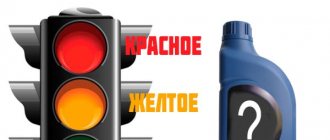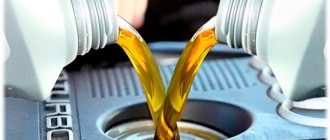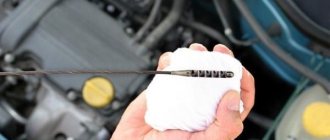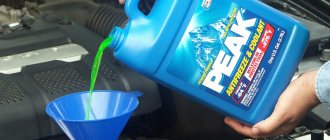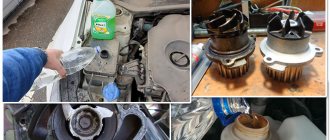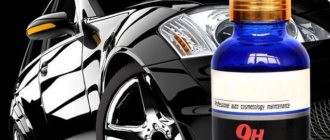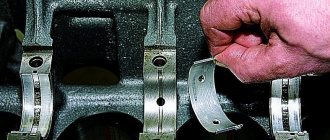Liquid cooling system
Liquid or water engine cooling systems are incredibly popular and common among automakers. Initially, ordinary water was used for such purposes. The advantage was that it was easy to get even in extreme situations.
However, water as a coolant has its disadvantages:
- corrosion begins quickly;
- when using dirty water, it is necessary to flush the system;
- low freezing temperature;
- rapid boiling;
- active evaporation;
- frequent engine failure;
- the need for constant monitoring of the cooling system;
- a large amount of sediment when using untreated water, etc.
Manufacturers realized that you can’t go far on water. First, glycerin and alcohol were added to the water. The composition has improved and modernized. As a result, we received special coolant, which is called antifreeze. The concept of antifreeze is also actively used in the post-Soviet space.
Let's look a little at the classification so that you can further understand whether motorists can mix compounds in certain situations. Namely:
- different brands;
- different manufacturers;
- different colors, etc.
Some are sure that antifreeze and antifreeze should never be mixed. Others believe that even if you mix red with green, red with blue, or yellow with any other colors of coolant, absolutely nothing terrible will happen. So we will find out who is right.
What happens if you mix antifreeze with antifreeze?
Firstly, the question is why mix these two different refrigerants. Well, various circumstances happen on the road, for example, there is an antifreeze leak and after eliminating the leak, you need to add antifreeze. But there is not always a canister of antifreeze in the trunk, and here they sell antifreeze nearby on the side of the road. You have to buy it and top it up to continue moving forward.
Or, as often happens, sooner or later after buying a used car, you have to top up the coolant, and then the driver asks the question: what was filled in before? Color is easy to determine, but classes are difficult. In such cases, experts recommend, again, not to save, but to drain the old fluid and fill in the new one in full. It is even possible that the old one has expired.
But, let's look at what happens after adding antifreeze to antifreeze.
From the composition we know that they only have in common water and, perhaps, a standard (ethyl alcohol). And each manufacturer adds different additives and additives in different quantities. Therefore, when mixing antifreeze and antifreeze, a sediment may form that will settle in the channels and on engine parts, which will gradually reduce the life of the internal combustion engine. Nothing bad will happen when adding antifreeze to antifreeze if their components are basically the same, but this cannot be checked with your own hands without a chemical laboratory.
Based on the above, we conclude that if you already had to mix antifreeze and antifreeze, then upon arrival, it is better to drain this liquid, do a complete flush of the engine cooling system and fill in a new homogeneous mixture. The cost of buying new antifreeze will save you a lot of money, effort and time.
A little classification
Currently, 6 compositions are used for automobile engines, or more precisely for their cooling systems:
They can be from different companies, the same color, different shapes, types, etc. That is, color is not a fundamental criterion here. Therefore, one type of composition can be blue and green, yellow and red, etc.
Let me tell you about each composition separately.
- Antifreeze. An old type of antifreeze, developed during the USSR specifically for Soviet cars as a response to imported antifreeze. Consists of a regular aqueous solution using complex alcohols. This includes ethylene glycol and special protective additives;
- G11. Traditional coolant based on ethylene glycol, water and additives. Silicates, phosphates, as well as borates, nitrites, etc. are used as additives. They do not have long service life. Main color is blue;
- G12. Carboxylate automobile antifreezes, to which, in addition to the components from G11, carboxylates are added. These are compounds of a fairly effective carboxylic acid. The coolant lasts a long time, the composition is mainly painted red or pink;
- G12+. A hybrid fluid based on water, as well as ethylene glycol, carboxylate, silicate, nitrite and phosphate additives. The composition of the coolant may vary depending on the manufacturer and its geographical location. Mostly red;
- G12++. So-called hybrid liquids. An organic base and silicates are used. In many ways similar to G12+ antifreeze, but has a longer service life;
- G13. A new type of coolant, where ethylene glycol was abandoned and replaced with propylene glycol. This component is harmless, which is why it quickly gained popularity. It comes in pink and purple most often.
But you must understand that any of the antifreeze presented can be painted in completely different colors. This has nothing to do with the composition. Color is a purely decorative component.
Initially, manufacturers wanted to stand out by changing the color of the standard white liquid. But gradually everyone began to use different coloring options. Dyes are used for this.
Is it possible to mix automotive antifreeze of different colors and brands?
Manufacturers categorically do not recommend doing this; sales managers advise pouring everything that is the same color; logic dictates that it is permissible to interfere, as long as the composition of the additive package is the same... So where is the truth? What to take for an emergency top-up? How not to overpay for the original?
Remember! Antifreeze is chosen not by color, not by car make, but by tolerances!
The engine brand is not the car brand
There are many examples when there is permission to use coolant in, say, VAG engines, but it still does not fit one of the engines:
- G12+ for Porsche (N 052 774 F1) is not compatible with other VAG vehicles.
- MAN has approved two specifications: for cold and hot engines. In the first case, a classic “hybrid” (Typ 324 NF) is recommended for filling, in the second - a carboxylate composition (Typ 324 SNF). Hybrid coolant is not suitable for high-temperature engines, since silicates do not work at high temperatures, but precipitate.
The same color and class of additives does not mean parity composition
Confirmation that antifreeze, even of the same color, can have different properties can be found on any auto forum. The topic is called something like this: “I bought European antifreeze for a Japanese car” (or vice versa) and received a package of problems. Here motorists will be interested in a table from the Wolf concern.
Due to ignorance, owners of Korean Kia/Hyundai public sector vehicles with a green-painted hybrid coolant often encounter this. For topping up they usually take G11 from VW. Everything seems to be fine - both are “hybrids”, and the dye is the same. However, you cannot mix them!
The bottom line is that VAG uses silicates, and phosphates are prohibited. In Kia it’s the other way around: silicates are prohibited, but phosphates are allowed. In total, pouring G11 into Kia will result in a silicate coat, local overheating, and actively developing corrosion.
Do you have VAG? Stir safely, but not for long!
However, there are situations that are completely opposite to the one described. For example, VAG allows G11, G12+, G12++, G13 to be mixed together in any proportions. That is, you can mix yellow, green and lilac-violet antifreeze with each other, but with the only caveat - for a short period, followed by a complete replacement. The concern explains why this is so using the example of G13, to which a little G12+/G12++/G11 was added: the mixture noticeably loses anti-corrosion protection, which is why it is not suitable for long-term use.
Attention! Only G12 can be added to G12.
Mixing issue
If you think that it is completely safe to mix red with red, but blue and green car antifreeze should under no circumstances be combined with each other, do not rush to conclusions.
First of all, I advise you to read the material on choosing the best antifreeze. Here is a link to this article. It is recommended for all cars to choose only the highest quality compounds. Moreover, it is not so important whether we are talking about antifreeze, or whether it is motor oil, a flushing agent or some kind of rust converter. We put quality first. And it will be better if you constantly start using the same antifreeze.
It is better to mix compounds in winter and summer in emergency situations, when there is simply no way to find the original coolant. If you buy a concentrate, then you simply have to mix it with water. But not from the tap, but with special, purified and distilled water.
As you understand, coolants differ in composition and additives used. And many of them can coexist in the same liquid without causing sediment or forming a gel from antifreeze.
If you mix coolants that differ in manufacturer and color, no disaster will definitely happen. But you shouldn’t experiment without urgent need. In the worst case scenario, the resulting mix will not last as long as you originally expected.
Motorists are interested in the possibility of mixing:
- compositions of the same color;
- mixtures from different companies;
- G11 and G12;
- G12 and G12+;
- G12 and G13;
- Coolant from different companies (for example, Sintek and Felix)
- antifreeze and antifreeze;
- G11 and G12++;
- G12++ and G13;
- red and blue;
- blue and green;
- pink and purple.
The list goes on and on as there are so many potential combinations.
But you should rely on generally accepted rules. They will be the basis for making decisions regarding mixing different coolants in emergency situations.
These rules read as follows:
- do not mix coolants that belong to classes 11 and 12;
- it is allowed to combine G11 with G12+ and even with G13;
- if necessary, you can combine 12 and 12+;
- in the case of a combination of 12 with 12++ or 13, it is better to refuse such a mixture;
- It is not forbidden to combine 12, 12++ and 13 in parallel.
Agree that it is quite difficult to keep such formulas in mind. But sometimes it is better to have the appropriate knowledge in order to avoid mistakes.
Fake antifreeze
Actually, it seems to me that the topic is completely covered! BUT what I would like to say finally is - have you ever wondered why some formulations, say branded or serious companies, are expensive, but there are formulations that are very cheap?
The same G13 antifreeze, made under the patronage of Volkswagen (usually purple), can cost 300 rubles per liter
And the yellow one, let’s say the same G13, produced somewhere unknown and not clear by whom, can cost the same money only for a 5 liter canister.
The whole point here is “fake”, because a high-quality liquid will not be cheap, and it will also meet all the characteristics and safety requirements, such as:
- Will boil over 100 degrees (usually 105 to 110 degrees)
- When boiling, will not ignite
- Will not lose characteristics
When you buy cheap antifreeze, you simply cannot test it, but it’s not uncommon for it to boil well below 100 degrees! Because of this, your engine can simply overheat and fail.
And when mixing cheap and expensive options, always think, HAVE YOU CHECKED THE QUALITY OF THE INEXPENSIVE PRODUCT? Does it meet the standards? Otherwise, you will simply ruin the branded expensive and high-quality liquid!
Therefore, most antifreezes can be mixed, but everything must be done wisely!
Now this is a useful video, I recommend it to everyone.
I’ll finish this, read our AUTOBLOG.
( 32 votes, average: 4.56 out of 5)
Drawing conclusions
Practice clearly proves that drivers can mix coolant from different brands and manufacturers in the tank, even if they have the same class and chemical composition. In such situations, it is unlikely that sediment that is dangerous for the cooling system of a car engine will form.
Here it is recommended to navigate not by color, but only by the direct chemical composition. Color is created by dyes, and therefore has no real meaning. That is, compositions that have exactly the same components, identical from a chemical point of view, can easily have completely different colors. Therefore, a combination of any colors of antifreeze is allowed, provided that their composition is the same.
Only here you should be careful. There are a large number of fake coolants on the market. No one can say for sure what their composition is. Therefore, when combining counterfeits, it is impossible to guarantee the normal operation of the system.
Let's hope I was able to answer all your questions. If not, write in the comments.
Thank you for your attention! Subscribe, ask questions and invite your friends to join us!
( 3 ratings, average: 5.00 out of 5)
Did you like the article?
Subscribe to updates and receive articles by email!
We guarantee: no spam, only new articles once a week!
There was a small leak from the expansion tank, now you need to add about 1 liter of antifreeze so that it is right in the middle between the min marks. and max. But I don’t know what’s in the tank... and I don’t want to change all the fluid.
Is it possible to mix different brands of antifreeze?
Let's start with what classes of antifreeze there are. This:
Antifreeze G11 is a liquid of inorganic origin and contains silicates. Available in blue or green colors. Suitable for old cars.
Antifreeze G12 is a liquid of organic origin. Produced in pink and red flowers.
Antifreeze g11 and g12 what is the difference
The difference between antifreeze g11 and g12 is that inorganic G11 contains substances that protect against corrosion (inhibitors). Thanks to corrosion inhibitors, a film is created on parts and protects it from contact with oxygen, which causes the metal to rust. Antifreeze GI 11 is glycol-based, that is, if you do not add corrosion inhibitors, the aggressive glycol will begin to corrode metal parts. OX G11 must be changed at least once every 2-3 years. The common color of JI-11 is green. Green G11 is the lowest class.
As for G12 class antifreezes, they are based on carbosilicates. Since many parts in an internal combustion engine are made of aluminum and steel, upon contact with liquids, destructive films are formed on their surfaces. The additives contained in GI 12 prevent the formation of a destructive film (the technology is called Long life). The substances in G12 do not form a protective film on all surfaces of channels and parts, but only where pockets of corrosion have appeared, in order to protect against further destruction of the metal. This class of antifreeze begins to boil at a temperature of 120 degrees. Service life 5 years.
G12 antifreeze can be poured into the engine cooling system only if the engine parts are not made of non-ferrous metals. Otherwise, the carboxylate liquid will corrode them.
You can and cannot mix:
- If the antifreeze contains one base, then you can mix it.
- Silicate-free antifreeze should not be mixed with others.
When mixing antifreeze of different classes and brands, a reaction of the additives occurs and precipitation appears, but not immediately, but after heating to the operating temperature of the engine. This means that these sediment particles will clog the radiator channels and settle on engine parts.
If you had to mix G11 and G12, then after that this mixture must be drained and the system flushed several times. These two classes should not be mixed.
G11 and G12 cannot be mixed. Even if you add just a little bit of 11 to 12, the 12th will lose its properties.
G12 and G12+ can be mixed, but you shouldn’t. Although they have the same base, manufacturers could add different additives that will react with each other. With the index + it only means that it is new generation. Service life 5 years or 250 thousand km.
G13 is a new class of liquid for the internal combustion engine cooling system. The main antifreeze composition is propylene glycol (for G11,12,12+ ethylene glycol). It is more expensive, but more environmentally friendly and contains fewer poisons. Used in powerful engines of sports cars and motorcycles.
Coolant and its composition
What is antifreeze
Antifreeze is a special coolant designed to prevent the risk of engine overheating. With its help, the proper temperature is maintained and heat is removed.
According to technological requirements, the operating temperature must be kept within certain limits. When it is exceeded, various breakdowns occur, including irreversible ones.
You also need to oh, “antifreeze” and “coolant” are equivalent concepts. Motorists use in their everyday life the terms to which they are accustomed.
Main differences
In conclusion, it is worth summarizing the differences between antifreeze and antifreeze:
- Antifreeze is a brand of antifreeze, and antifreeze itself is a general name for all coolants.
- Antifreeze contains inorganic salts, and antifreeze contains organic salts.
- The service life of antifreeze is no more than 40 thousand kilometers, while antifreeze can last 200-250 thousand kilometers.
- Antifreeze guarantees protection on the walls equal to 0.5 mm, which impairs heat transfer. As for the “competitor,” it leaves protection only in weak areas where corrosion occurs.
- Antifreeze can withstand temperatures up to 115 degrees Celsius and does not boil, while antifreeze is less resistant to high temperatures.
Is it possible to mix
Components
In this case, it is necessary to take into account the composition of the liquid. It includes several substances:
- ethylene glycol – dihydric alcohol;
- antifoam additives;
- lubricants;
- anti-corrosion additives.
Alcohol acts as the basis of the coolant. It ensures proper heat transfer and does not freeze at low temperatures, which is very important for the safety of the entire cooling system.
Accordingly, it is necessary, recalling school physics and chemistry lessons, to remember how different liquids mix with each other.
Antifreeze and water can be mixed
Antifreeze contains the same elements: water and ethylene glycol. Antifreeze was invented in the USSR in 1971.
Classification of antifreeze by type:
- A - ready to be poured into the car’s cooling system.
- M - modernized, that is, it contains additional components.
- K is a highly concentrated liquid, it will have to be diluted.
After the letters, which are divided by type, write 2 numbers - subzero temperature, at which the antifreeze will not freeze. For example, M40, or M65.
The color of good antifreeze is between blue and light blue; there is also a greenish color. Antifreeze brand A65 is red. Legal in Russia, GOST 28084-89 distributes three types of OZh-K, OZh-40, OZh-65. If there are no coolant (coolant) designations, there is only a GOST number, then it is a fake.
Mixing
What to do if you have to mix
However, it should be noted that there are quite a lot of situations when you have to mix different types of antifreeze. Any car store offers a variety of products from different manufacturers, so making a choice becomes very difficult.
Sometimes you can successfully hit it “at random” and choose types of liquids that interact well with each other. But sometimes it happens that they lie in layers and in this state disrupt the operation of the cooling system.
The main element is ethylene glycol. The alcohol base of all coolants allows us to hope that mixing will occur normally. However, the whole thing is spoiled by numerous chemical additives designed to improve physical and chemical properties.
Consequences of mixing antifreeze and antifreeze.
If antifreeze and antifreeze are successfully mixed, that is, when you are lucky, the main components of the composition of both liquids are the same, then there will be no formation of sediment and clogging of channels. But, it is very difficult to know the composition of both liquids.
If the bases of these liquids are different, then when adding antifreeze to antifreeze or antifreeze to antifreeze, the liquid may immediately become cloudy and with sediment, or this will happen after natural heating of the engine or using engine preheating.
Adviсe
Tips for choosing antifreeze
- Try to choose the same antifreeze.
- Pay attention to the class, composition and recommendations of the manufacturers.
- If you cannot find the same antifreeze, try to choose one that is as close in type as possible.
- If you don’t know what kind of antifreeze you will be mixing with, choose a new liquid that is as universal as possible - with a minimum amount of chemical additives and additives.
By following these recommendations, you can hope that mixing different antifreezes will be “painless,” and the cooling system will quietly switch to the new liquid.
Immediately after adding new antifreeze, you should carefully monitor the condition of the car engine.
If any problems are observed - unstable operation, “sneezing”, increased temperature, it is better to completely change the coolant and check the entire system.
Mixing different brands of antifreeze
In fact, it is impossible to unequivocally answer the question about mixing different brands of antifreeze. The world is full of positive examples when several types of antifreeze continued to perform their direct functions in the car system. However, everything can end quite sadly. Yes, the main “element” of antifreeze is ethylene glycol, but its manufacturers strive to make their product either better quality or, on the contrary, more accessible to consumers. In this connection, they endow antifreezes with the help of additives with all sorts of useful properties and to completely different degrees. Any additives are a mass of chemical compounds. Therefore, in order to really safely mix several types, you need nothing less than a chemist’s degree and to foresee the occurrence of serious reactions in advance.
Thus, it is more correct to say that mixing different brands of antifreeze is not recommended unless you want to get the exact opposite effect and endanger the car’s systems. For this reason, you should always carefully and carefully approach the choice of coolant and pay attention to additives. In addition, it is important to change the liquid on time, since over time it loses its properties.
Cars with internal combustion engines require a cooling system that can be filled with any liquid: plain water, distilled water, antifreeze, antifreeze.
Is it possible to mix antifreeze and antifreeze?
Is it possible to mix antifreeze and antifreeze, coolant classes G11 and G12, is it worth flushing the engine after that?
You can find conflicting information on various forums, some say you can mix, others not. Some started having problems after mixing, while for other car owners everything was fine.
Before answering the question of whether mixing different types of coolants is allowed, we highlight the following points:
- It is prohibited to rely on color when considering whether to mix coolant or not. There is no guarantee that the manufacturer followed the rules. Most often, the coolant shade is chosen not based on classification, but to attract customers, for advertising purposes, or to facilitate troubleshooting.
- It is allowed to add the same type of antifreeze to the system. So, if G11 is already present in the cooling system, then it is worth adding it. If G12, then it is recommended to fill it with G12.
- When mixing, it is worth considering the composition of the consumable material and the type of additives. Each manufacturer adds a specific set of additives to its product - anti-foam, anti-corrosion and others. Today, there are dozens of types of additives, which complicates the mixing of certain compounds. If you thoughtlessly pour coolant into the system, you can get a “mix” of additives that will not help the engine, but will ruin it.
- It is prohibited to mix antifreeze with antifreeze due to the different composition. Thus, domestic coolants have an aggressive effect on the cooling system due to the presence of silicate in the composition. As for antifreeze, it does not contain this element, but there is a wide range of other additives.
- It is forbidden to mix antifreezes that are part of the silicate-free group.
When replacing one element with another, it is recommended to flush the cooling system using a special composition. If this is not done, the metal elements of the engine will quickly rust.
In addition, sediment accumulates in the system, clogging the channels and impairing the beneficial properties of the coolant. In this case, mixing is allowed if the liquids have an identical composition but a different color.
In which cars should I use antifreeze, and where should I use antifreeze?
Against the background of the considered features of different types of coolants, the question arises of what is recommended to be used and in what case.
The first thing you should focus on when choosing is the make of the car and the manufacturer’s recommendations. The developers specify in the vehicle manual which consumables are best to use.
But these are only recommendations. In practice, the car enthusiast takes responsibility for the choice onto his own shoulders.
So which is better? Please note the following points:
- Antifreeze can be used on old domestic cars of the VAZ, Moskvich and other brands. For foreign cars, high-quality antifreeze is more suitable (reasons are described below).
- The use of antifreeze leads to a decrease in power, increased fuel consumption and rapid engine wear.
- Antifreeze is more loyal to aluminum engine elements. If you use antifreeze in cars with a radiator made of this metal, you will soon need to purchase a new unit.
- When using antifreeze, the service life of the water pump is reduced, the radiator and thermostat become dirty faster.
- Antifreeze does not have a detrimental effect on the rubber and plastic elements of the cooling system, which cannot be said about its “competitor”.
